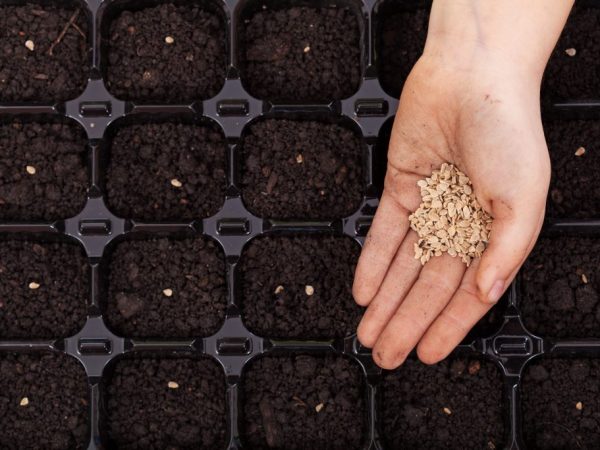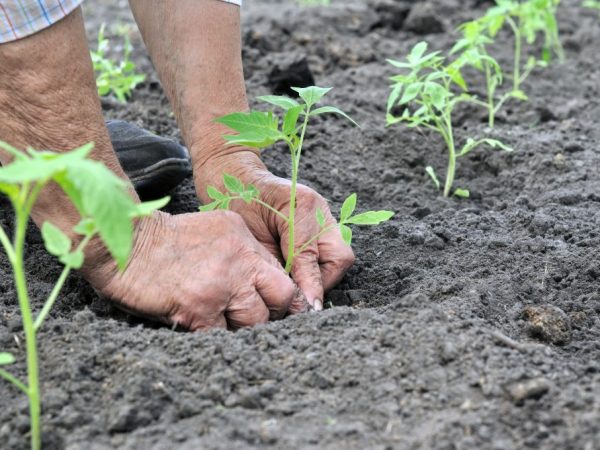What should be the depth of planting tomatoes
Tomato is one of the most common types of vegetables. For a good harvest, you need to follow the rules for its cultivation. This is the preparation of seeds, soil, containers for growing seedlings. The sowing depth of tomato seeds is also of particular importance. It depends on how well the seedlings will sprout.

Planting depth of tomatoes
How deep to sow seeds
Before you start sowing tomatoes, you need to prepare a special container. For this, cups, cassettes or shallow boxes are suitable. Wet soil is poured into the container and furrows should be made about 1 cm deep, the distance between them should be about 3 cm. If the seeds are not planted very close, then the sprouts can not be dived in the future.
There is another landing option. You can put tomato seeds on pre-prepared soil and then sprinkle with soil in a layer of 1 cm.
Landing features
The seeding depth also depends on the plant variety. Tall varieties are planted 1.5 cm deep in order for them to take root better. Low-growing species can be sown to a depth of 8 mm. This will improve seed germination. It is necessary to take into account the type of soil. If it is heavy, the seeds will sprout later, and if fluffy, the sprouts will break through in 2-4 days.
If you sow tomato seeds shallow, they can become bare during watering. In such a situation, there are 2 ways out:
- fill up the earth by 1-1.5 cm;
- instead of watering, spray seedlings from a spray bottle.
After sowing the seeds, the soil must be kept moist at all times. As the bushes grow, the amount of water is reduced.
Tatiana Orlova (Candidate of Agricultural Sciences):
The soil in the seed boxes must be lightly compacted before sowing. This is done so that the seeds fall to the same depth, otherwise the germination capacity (germination energy) will be low. Some seeds will sprout earlier, others a little later, and the degree of development of the seedlings and their readiness for picking will differ.
Consequences of improper sowing of tomato seeds
Tomatoes' future harvest depends on the depth of planting. If you choose the wrong sowing depth for tomato seeds, you can get weak bushes, which will give a small harvest in the future.
If the seeds are sown too deep, there is a chance that they will not germinate and will rot. The sprouts that break through will be weak, and their first cotyledonous leaves will be injured. This affects the quality of photosynthesis of a young plant.
How deep to plant tomato seedlings

Planting depth is important for plant development
In order for the plants to take root, you need to know how deep to plant tomatoes. It is necessary to plant seedlings in a hole 7-8 cm deeper than the depth in which it grew before. The bottom two leaves need to be torn off and the roots placed in the hole, the stem should be covered with soil about 8 cm.
You can not be afraid that the plant is planted too deeply, since when watering the soil will settle down a little, and a small depression will form around the plant, which will hold water.
Tatiana Orlova (Candidate of Agricultural Sciences):
Tomato, one of the plants that easily forms additional roots on the stem when in contact with moist soil. This feature can be taken into account when planting seedlings. Deeper planting (up to cotyledon leaves) promotes the growth of additional roots. This property is absent in pepper and eggplant. They do not need to be buried during planting.
Planting depth of overgrown seedlings
If the seedlings are outgrown, then you need to plant them a little deeper. For this, the holes are made 7-10 cm deeper. Such a plant will be worse and take longer to take root in a new place. It is for this reason that it is not recommended to plant tomatoes later than 55 days after germination.
If the seedlings lacked sunlight during their growing season, then their stems are strongly stretched. The internodes become longer and thinner. Such seedlings should not be buried. They are dropped to the usual depth, but the stems are laid sideways in the hole. Subsequently, the tomato can grow additional roots in this place.
Planting depth versus soil
Affects planting depth and soil quality:
- If the area where the tomato bed will be located consists of rocky soils, then you need to plant the plants a little deeper. Such soil is well drained and allows moisture to pass to deeper layers of the soil cover.
- Loams are denser and poorly permeable to water. If the hole is too deep, then the plant will not receive enough moisture and will soon die.
- Light sandy soils are highly susceptible to erosion by precipitation and blowing of the upper layer by winds. This feature of the soil causes a deeper planting of seedlings. Otherwise, the root system may be exposed.
Tatiana Orlova (Candidate of Agricultural Sciences):
Tomato is a plant that is demanding on soil conditions. As a rule, for growing tomato, the soil on the site is cultivated. Heavy soil needs to be lightened by the introduction of sand and mature humus, light sandy or sandy loam soil is made more bound and moisture-absorbing by the introduction of peat and other organic substances.
Conclusion
In order to grow good bushes and get a high-quality crop, you need to adhere to the rules of planting depth. Most often, this information is indicated on the back of the seed packet. If there are no such recommendations, then you can use the standard landing pattern. If the tomatoes are still buried, then you should not remove the extra layer of earth or rake the hole. The lateral buds of the stem are quickly rearranged underground. Roots grow from them, and disturbance of the soil cover will lead to their death. The root system is injured, and the plant itself stops growing.



